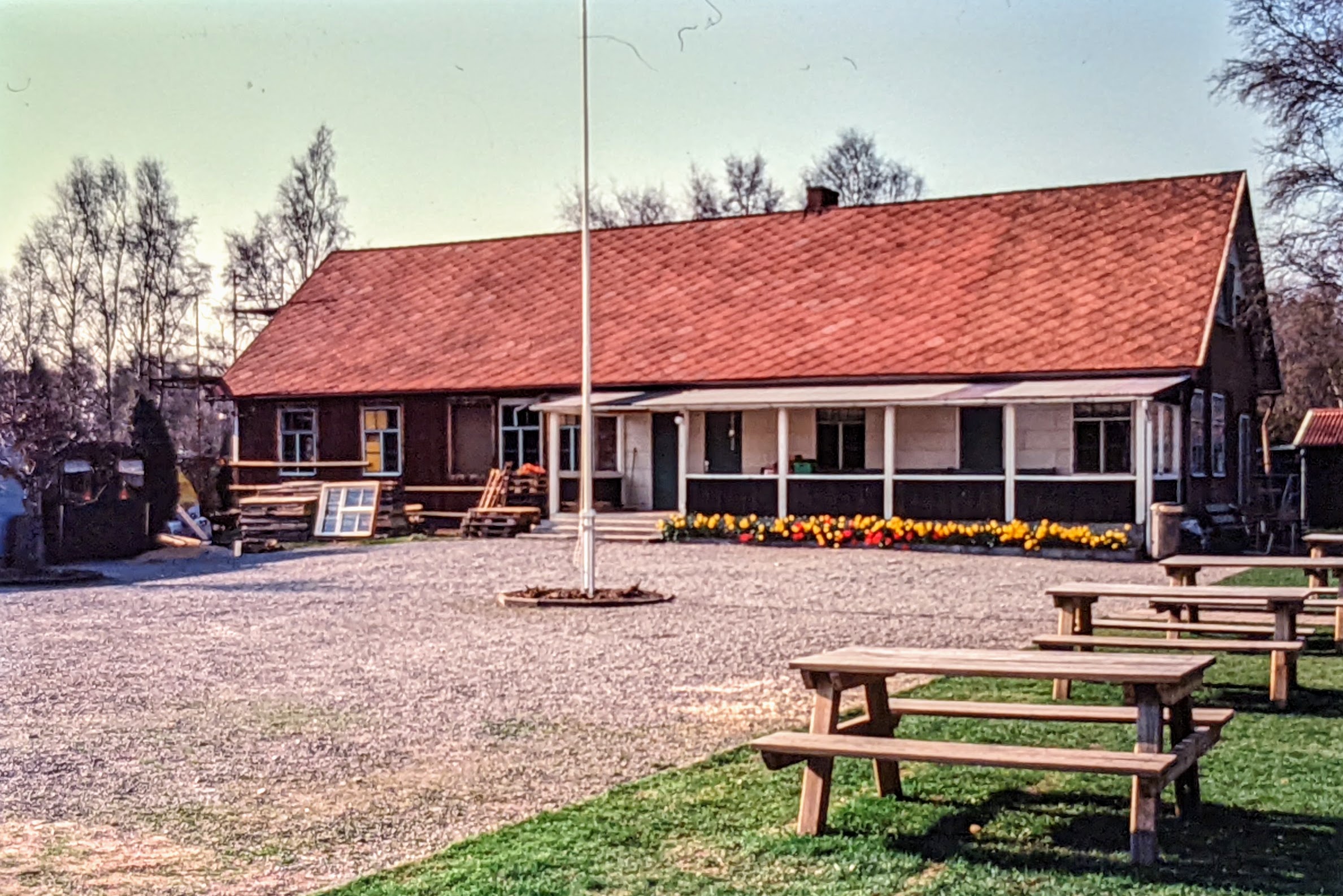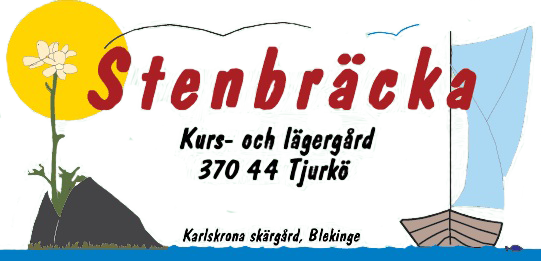In 2005, a joint archipelago camp will be carried out under the auspices of EFS Syd´ with about 60 young people. An electric vehicle is purchased. "Bed an Breakfast" is introduced together with Öboden's owners.
Vår historia

Stenbräckas Historia
Stenbräckas History
2005
2003
The name of the place is abbreviated to "Stenbräcka". Björn Pettersson and Krister are employed for Stenbräcka and Hägnan.
2002
Matsolof retires after 20 years as director. A youth team of 5 young people handles booking etc.
2001
Anniversary year. The association turns 40 years old. Stenbräcka Idéella förening has been around for 10 years. Two new floating bridges will be in place at the far bridge.
2000
A sailing course with folk boats is held.
1997
Five camping cabins are being built in Hägnan. The military protection area is removed and opens up for people from other countries to come to Tjurkö. Stenbräckagården introduces a meditation area between Stenbräcka and Hägnan.
1995
The association buys hostel and barn from Karlskrona.
1994
The campsite is expanded with a simpler Nature Camping.
1993
The barn, basement and stable are being renovated. A new roof is being laid on the hostel. A bakery cabin is built and fitted out. Café Hägnan will be started with 8 program evenings during the summer. A Tent archipelago camp and an Adventure camp will be carried out in May, bringing together about 120 participants. "Hägnandagen" is held for the first time.
1992
The association started conducting camping activities in Hägnan. A shower and a water heater were installed and the car park was expanded.
1991
A maintenance agreement was signed with Karlskrona municipality regarding property, bathing area and road.
1990
Consultation in January with the congregations of the Church of Sweden in the contract with a request for a written permanent cooperation agreement on the farm to enter into force on 1/1 -91. The director's position was expanded to 100% from 1/1 1990. This year the use of Tjurkö church was regulated in an agreement with Ramdala-Sturkö pastorate. In the summer of '90, after the application, a grant of SEK 80,000 was received from the General Heritage Fund for a project called Skärgårdshemmat Hägnan - a 1930s environment with self-catering and recycling linked to today's environment. 50,000 was received from the Culture Committee over 5 years for the same project. In the autumn of 1990, pipelines were laid in Hägnan for electricity to camps and trolleys and a better water supply to the area.
1989
On 1/1, Ramdala-Sturkö pastorate Tjurkö church took over from the City Council. In March, a new water treatment plant was commissioned. The carpentry shop was built as a student project of Chapmansskolan's construction line. The parking lot was prepared and the ball field was extended towards the church and drained via the Park Office. New roof on the barn in Hägnan and Logen got a new outer wall.
1988
At midsummer, Villa Västrabo could be inaugurated. In the same year, a new sewage treatment plant was started. After a lot of explosions due to rock, the facility could finally be completed on 5/10.
1987
The association decided to build Villa Västrabo and the first sod was taken in June. On 14/12 it was decided that the name of the farm would now be Stenbräcka course and camp farm or Stenbräckagården.
1986
Before the midsummer weekend of 1986, we were notified of a grant of 350,000 from the General Heritage Fund for the construction of a new annex. The farm's 25th anniversary was celebrated during the midsummer weekend with the participation of e.g. Iris and Bertil Ohlsson, Veste Brynestam and Matsolof Arnoldsson. The cottages Granen and Hasseln were delivered as student work by Chapmansskolan's exchange line.
1985
There is a collaboration with the school office in Karlskrona on Archipelago Camp Schools on the farm. In the same year, the Main Building and Villa Östrabo were completely renovated at a cost of 1.3 million.
1983
Matsolof Arnoldsson was employed as manager at EFS-gården with a 50% project position. The Midsummer celebration was done for the first time with Tjurkö Intresseförening. An experimental activity is being started together with the Church of Sweden.
1982
Bishop's visit was held at the beginning of the year by Bishop Per Olof Ahrén when Tjurkö church and the EFS farm were also visited. On 8/6 -82, a consultation was held with the contract about possible cooperation on the farm.
1981
At midsummer, the 20th anniversary of Ungdomsgården was celebrated with the participation of e.g. Iris and Bertil Ohlsson, Veste Brynestam and Matsolof Arnoldsson.
1979
Decision to have talks with the Church of Sweden in the contract for a collaboration around the farm.
1974
At Ungdomsgården, 6 sleeping cabins and a manager's cabin will be built at an estimated cost of SEK 85,000.
1973
The lodge in Hägnan's barn is being prepared.
1972
A path is cleared from Ungdomsgården to Hägnan. A shower and sauna shed is being built.
1971
Summer church activities with bathing meetings and worship / devotion in Tjurkö church are tried in connection with the swimming school's activities.
1969
When the municipality set up a new municipal bathing place in Hägnan, Ungdomsgården was given the right to use the rest of the area around the buildings in Hägnan.
1967
Veste Brynestam, who was a youth pastor in the district, was elected to also be the director of EFS Ungdomsgård within his position. Contact was made with homeowner Otto Karlsson, Hägnan, about the right of the farm to stay on Otto's land and to arrange a campfire by the beach.
1965
The extended Mission House and the newly built housing building (now Östrabo) will be inaugurated at Pentecost. It was decided to call the farm EFS Ungdomsgård, Tjurkö. It was decided to purchase more land, 3,000 sqm, between the Mission House and the Church for the preparation of a ball field.
1963
Decided to buy land and to build for the Mission House. With a contribution of 60,000 from the Allmänna Arvsfonden, construction could start.
1962
During 1962, renovation work was carried out in the Mission House. On Pentecost, 10/6 -62, EFS Sommarhem, Tjurkö was inaugurated. Those who participated were committee member Gustaf Abrahamsson, editor Joh. Wessmark, preacher Halvard Holmqvist, preacher Bertil Ohlsson, pastor Gunnar Olén and circuit singer. About 250 people were present. A program sheet Tjurkö-Nytt was published before the inauguration.
1959
1928
A mission house was built and completed in 1928.
1926
The Lutheran Youth and Missionary Association is founded with 37 members
